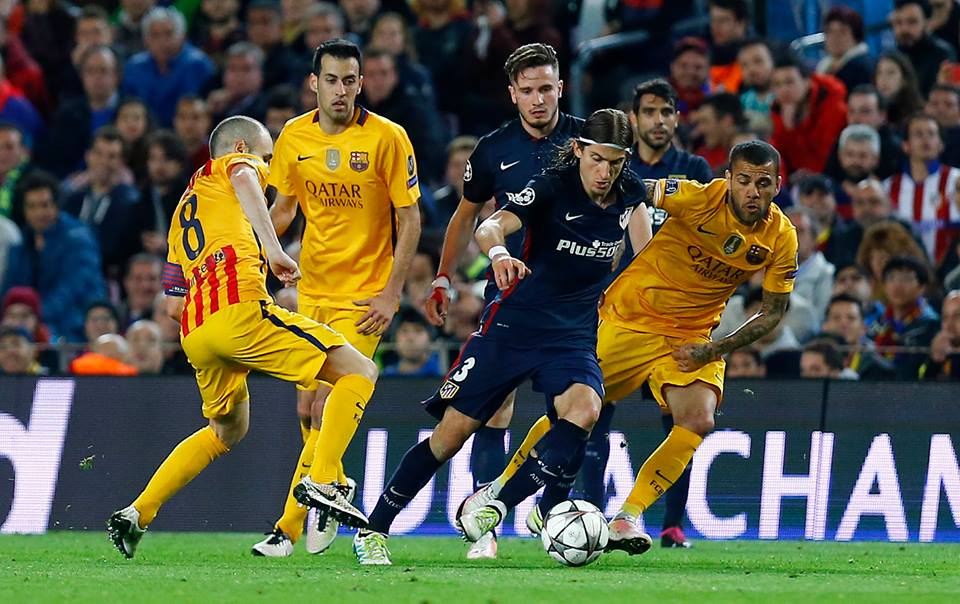How and where: Barcelona got past a stubborn Atletico
Barcelona beat Atletico Madrid 2-1 via two Luis Suarez goals, but it was the width offered by Alba and Alves that won the game for the home side. After a sluggish first half, Enrique’s men turned the tie on its head thanks to a Torres red card and quicker transitions and better ball movement.

Torres’s moment of madness
Fernando Torres has lost his pace, his burst of speed and his finishing in the past few years. Last night he also lost his head for a brief period. After slotting in the opener between Ter Stegen’s legs, the Spanish striker went in on Sergio Busquets to win the ball. The midfielder smartly shielded the ball away inviting Torres to commit a foul and the striker didn’t disappoint, picking up his second booking of the night and thus earning an early shower, as early as the 31st minute.
What it meant for Atletico wasn’t realized immediately, as the Madrid side maintained their shape and fell even deeper, squeezing the centre of the park much like they had done from kickoff. Barcelona never found their rhythm, and Atletico continued to halt their progress as soon as the Catalans came anywhere near the box. The idea was simple for Simeone’s men, protect the centre of the pitch and make use of the height advantage if the home side
The width conundrum
Luis Suarez may take away the headlines off Torres after his brace, but it was the fullback pairing of Jordi Alba and Dani Alves that made all the difference. It’s no coincidence that the 2 Suarez goals were assisted by the duo.
With the Madrid side having to defend a lead, it was palpable that they would look to sit deep and that gave license to the two fullbacks to maraud forward without much fear. Alves, in particular, had one of his most productive nights, crossing the ball 10 times and finding a teammate thrice. Of those 10 crosses, 8 were centered in the second half. Alba similarly attempted 5 of his 6 crosses in the second half. The width on offer was finally being exploited.

(Barcelona defending with eight men behind the ball)
With the play stretched and Atleti defending for their lives and crowding the box, the only way out was shifting the play out wide or shifting wide and drifting infield as Neymar did. But if it were so easy why did it take so long?
Transition play and the swiftness
The MSN trio of Messi, Suarez and Neymar have made a name for themselves on lightning-quick breaks. The formula for Barcelona in the past year has been simple, feed the forwards and they will rip the opponent defence to shreds. But like Real Madrid showed on Saturday night, that only works when the defence is backtracking. When the team is already sitting deep and comfortable, it becomes a challenge. So after the Clasico-hangover first half, Barcelona came out in the second with a blazing tempo. The ball movement was crisper, the transition play was smoother, and the players showed much more dynamism. The forward line started to dribble more, accelerate faster, and on hitting a roadblock, moved the ball to the wide players. What resulted was a panic-stricken Atletico defence.
Credit must be given to Luis Enrique, who surely recognized the mistakes made in the Clasico, and he avoided a repeat. The swiftness, the crossing and the directness in Barcelona’s second half approach meant the ball was coming into the box almost as soon as it left. Even a team as defensively sound as Atletico couldn’t handle the bombing, especially with players running at pace. Neymar with his dancing shoes on, in particular, kept the defence guessing with dribbles and shots sprinkled in almost perfect proportions. But the player who had the most contrasting two halves, unless you’re looking just at numbers (in which case Suarez wins hands down), was Lionel Messi.
Messi’s game of two halves
Lionel Messi, just like Barcelona, had a proper game of two halves. After a frustrating 45 minutes spent largely in a floater role in the middle of the pitch, Messi sparked to

(Messi in first half)(Image Courtesy: Whoscored.com)
The analysis would be incomplete and even a little unfair without taking off a moment to appreciate the effort put in by Simeone’s men, despite playing with one man short. Only two months back, the red and whites had almost stifled the same Barcelona side with 9 men, and they almost repeated the trick here. Simeone’s men were well drilled defensively and organized to perfection. Unfortunately for them, Barcelona had too much fire-power on the night. They will still take a 1-2 going to the Calderon though.
(Read about how Barcelona is on course for back-to-back trebles)

Comments
Sign up or log in to your account to leave comments and reactions
0 Comments